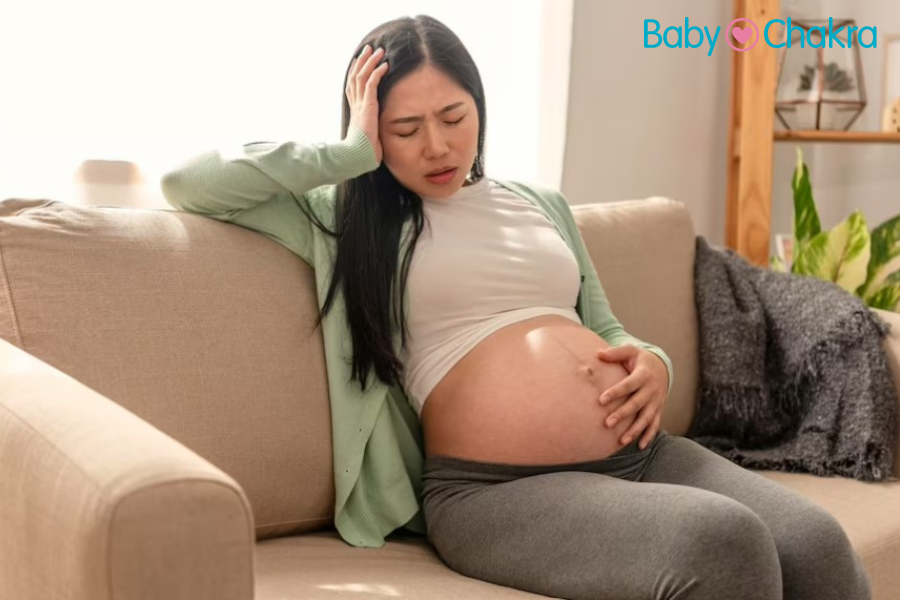
5 Different Types Of Contractions During Pregnancy And How They Feel
4 Apr 2023 | 6 min Read
Sudeshna Chakravarti
Author | 799 Articles
Contractions during pregnancy refer to the feeling of tightness or hardness in your uterine muscles. This pain or cramping sensation usually originates in your lower back and gradually moves to the front.
Some expecting mums may also feel as if they are having heavy menstrual cramping, or feel pressure and pain in their back. However, not all pregnant women experience the same symptoms.
Read on, as we tell you more about the different types of contractions during pregnancy, how to manage them and keep yourself comfortable during active labour, and when to visit your doctor.
Different Types Of Contractions During Pregnancy
It’s important to keep a check on your symptoms to identify the type of contraction you are having / Image credit: Freepik
Braxton Hicks Contractions
They are also known as prodromal or false contractions, and usually begin during the sixth week of pregnancy, and become more pronounced in the second and third trimesters. These contractions are considered a normal part of pregnancy and help prepare your body for labour. They do not cause your cervix to dilate.
What Do Braxton Hicks Contractions Feel Like?
These contractions are typically
- Infrequent and irregular and do not change in intensity
- Concentrated around your abdomen rather than the back
- Painless but quite uncomfortable
- Subside when you walk, lie down, or empty your bladder
Causes Of These Contractions During Pregnancy
The following factors may trigger Braxton Hicks contractions during pregnancy.
- Dehydration
- Intense physical activity
- A full bladder
How To Cope With Braxton Hicks Contractions?
The following steps ease your contractions and help you relax and calm down.
- Practicing deep breathing exercises
- Drinking water to hydrate yourself
- Practicing relaxing techniques, such as taking a warm bath, getting a massage, or taking a nap.
- Changing your position
Preterm Labour Contractions
These true labour/ birth contractions occur before your pregnancy reaches full term, before 37 weeks. In some cases, these regular contractions could also lead to preterm birth.
What Do Preterm Labour Contractions Feel Like?
The following signs indicate that you are having preterm labour contractions.
- A feeling of hardness in the abdomen
- Experiencing more than five painful contractions in an hour
- Regular and frequent uterine contractions
- Vaginal bleeding and discharge
- Abdominal pressure and pain
- Menstrual-like cramps
- Pressure in your pelvic area
If you experience any of these symptoms, you must see your healthcare provider immediately for further assessment.
Causes Of Preterm Labour Contractions
The factors that increase the risk if these contractions include
- Multiple pregnancies (twins or triplets)
- History of preterm labour
- Short space between your pregnancies
- High-stress levels
- Short cervix
- Abnormal conditions of the cervix, placenta, or the uterus
- Certain infections
- Lifestyle triggers, such as smoking, substance abuse, or obesity
How To Cope With These Contractions During Pregnancy?
To lower the risk of preterm labour, you should follow these early treatment methods until you see your doctor. These precautionary measures may also reduce your risk of having a preterm baby.
- Keep hydrating and emptying your bladder, as dehydration may also cause these contractions.
- Avoid lying down on your back. Lie down on one side, and use a pillow to support your back.
- Track your contractions per hour. Start with counting the minutes of one contraction to the next. If you have more than 4-5 contractions in an hour, it signals preterm labour.
Early Labour Contractions
During early labour contractions, you may feel pressure in your back, and experience nausea / Image credit: Freepik
These contractions are uncomfortable and feel like mild to moderate menstrual cramps. In this case, your cervix dilates to about four centimetres.
What Do Early Labour Contractions Feel Like?
We have discussed some of the common symptoms that you may experience during an early labour contraction. But keep in mind, since every pregnancy is different, you may not experience the same symptoms as others.
- Irregular contractions that are 5 to 20 minutes apart
- Contractions lasting about 30-45 seconds
- Severe cramps
- Dull pain in your back
- Pressure or feeling of fullness in your pelvic region
- Pain radiating from the back to the front
- Difficulty in breathing
In some cases, first-time mums may have several hours of early labour contractions without any signs of cervical dilation. Regardless, if you experience any of the above-mentioned symptoms, go to the hospital or contact your healthcare provider.
Active Labour Contractions
These contractions are painful and indicate that your delivery is approaching. Your cervix dilates from four to 10 centimetres in this stage.
What Do Active Labour Contractions Feel Like?
The following symptoms may indicate that you are having active labour contractions.
- Your contractions will be 2-3 minutes apart
- Your contractions will last between 50-75 seconds
- You will experience a strong urge to push
- You will feel pressure and pain in your back as your baby ascends down to the birth canal
In addition to these symptoms, you may experience lightheadedness, nausea, gas, and vomiting. Make sure to keep yourself hydrated, and practice breathing exercises to calm your mind.
Transition Contractions
These contractions are considered the most painful part of labour. They last for 60-80 seconds and occur every 2-3 minutes apart. During this stage, your cervix will dilate to 7-10 centimetres.
These contractions are also associated with intense pressure in your rectal and vaginal regions. You may also experience nausea, vomiting, and chills.
Steps To Keep Yourself Comfortable During Active Labour And Transition Contractions
The following tips will help you deal with the pain and pressure of the contractions.
- Change your position or walk a bit
- Keep drinking water as it gives you the strength to get through the labour
- Eat well
- Get a relaxing lower back or foot massage
- Practice relaxation techniques, such as meditation or yoga. This can help you regain energy and focus.
Conclusion
Differentiating between the different types of contractions during pregnancy is a difficult task. Hence, it’s a good idea to remain attentive to each signal your body gives you. If you experience any serious or abnormal symptoms, make sure to consult your doctor immediately, as they will be able to guide you on the further steps, and determine whether you need immediate medical attention or not.
Recommended Baby Care Products:
Also Read:
Symptoms of labour pain: Watch out for these symptoms of labour pain to understand when to reach the hospital for your delivery.
Pregnancy trimesters: Here’s everything you need to know about the different trimesters of pregnancy.
Breast changes during pregnancy: Check out this post to learn all about breast changes during the different pregnancy trimesters.
Cover Image Credit: Freepik.com
A


Related Topics for you
Suggestions offered by doctors on BabyChakra are of advisory nature i.e., for educational and informational purposes only. Content posted on, created for, or compiled by BabyChakra is not intended or designed to replace your doctor's independent judgment about any symptom, condition, or the appropriateness or risks of a procedure or treatment for a given person.



